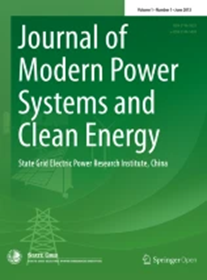Transfer-Learning-Based BiLSTM-WGAN Approach for Synthetic Data Generation of Sub-Synchronous Oscillations in Wind Farms
IF 6.1
1区 工程技术
Q1 ENGINEERING, ELECTRICAL & ELECTRONIC
Journal of Modern Power Systems and Clean Energy
Pub Date : 2025-01-20
DOI:10.35833/MPCE.2024.000550
引用次数: 0
Abstract
The phenomenon of sub-synchronous oscillation (SSO) poses significant threats to the stability of power systems. The advent of artificial intelligence (AI) has revolutionized SSO research through data-driven methodologies, which necessitates a substantial collection of data for effective training, a requirement frequently unfulfilled in practical power systems due to limited data availability. To address the critical issue of data scarcity in training AI models, this paper proposes a novel transfer-learning-based (TL-based) Wasserstein generative adversarial network (WGAN) approach for synthetic data generation of SSO in wind farms. To improve the capability of WGAN to capture the bidirectional temporal features inherent in oscillation data, a bidirectional long short-term memory (BiLSTM) layer is introduced. Additionally, to address the training instability caused by few-shot learning scenarios, the discriminator is augmented with mini-batch discrimination (MBD) layers and gradient penalty (GP) terms. Finally, TL is leveraged to fine-tune the model, effectively bridging the gap between the training data and real-world system data. To evaluate the quality of the synthetic data, two indexes are proposed based on dynamic time warping (DTW) and frequency domain analysis, followed by a classification task. Case studies demonstrate the effectiveness of the proposed approach in swiftly generating a large volume of synthetic SSO data, thereby significantly mitigating the issue of data scarcity prevalent in SSO research.基于迁移学习的风电场次同步振荡综合数据生成的BiLSTM-WGAN方法
次同步振荡现象严重威胁着电力系统的稳定运行。人工智能(AI)的出现通过数据驱动的方法彻底改变了SSO研究,这需要大量的数据收集来进行有效的训练,由于数据可用性有限,在实际电力系统中经常无法满足这一要求。为了解决训练人工智能模型中数据稀缺的关键问题,本文提出了一种新的基于迁移学习(TL-based)的Wasserstein生成对抗网络(WGAN)方法,用于风电场SSO的合成数据生成。为了提高WGAN捕获振荡数据中固有的双向时间特征的能力,引入了双向长短期记忆(BiLSTM)层。此外,为了解决由少量学习场景引起的训练不稳定性,该鉴别器被增强为小批量鉴别(MBD)层和梯度惩罚(GP)项。最后,利用TL对模型进行微调,有效地弥合了训练数据和真实系统数据之间的差距。为了评价合成数据的质量,提出了基于动态时间规整(DTW)和频域分析的两个指标,然后进行分类任务。案例研究证明了该方法在快速生成大量合成单点登录数据方面的有效性,从而显著缓解了单点登录研究中普遍存在的数据稀缺问题。
本文章由计算机程序翻译,如有差异,请以英文原文为准。
求助全文
约1分钟内获得全文
求助全文
来源期刊

Journal of Modern Power Systems and Clean Energy
ENGINEERING, ELECTRICAL & ELECTRONIC-
CiteScore
12.30
自引率
14.30%
发文量
97
审稿时长
13 weeks
期刊介绍:
Journal of Modern Power Systems and Clean Energy (MPCE), commencing from June, 2013, is a newly established, peer-reviewed and quarterly published journal in English. It is the first international power engineering journal originated in mainland China. MPCE publishes original papers, short letters and review articles in the field of modern power systems with focus on smart grid technology and renewable energy integration, etc.
 求助内容:
求助内容: 应助结果提醒方式:
应助结果提醒方式:


